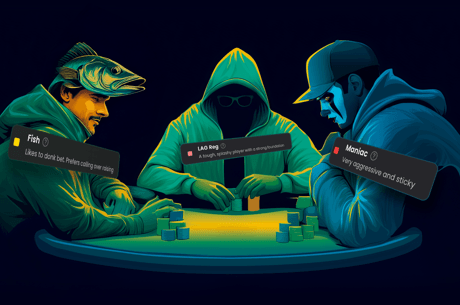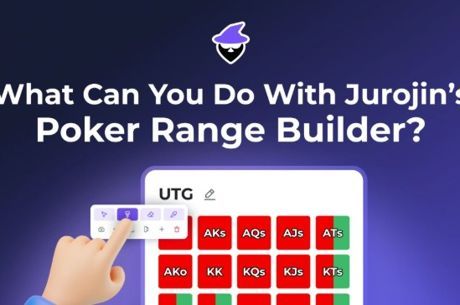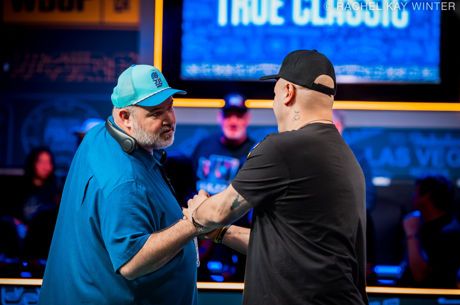In and Out of the Luckbox: A Hold’em Hand Distribution Simulator

Do you ever get the feeling that you’re having the worst run of cards ever, while everyone else (or at least a couple of others) on your table are running like the poker gods have blessed them unfairly?
As a matter of fact, you’re probably right.
We all know that in the long run the cards show no favoritism. Sit at a poker table long enough and you’re statistically likely to get just as many good hands as anyone else. But in the context of a multi-hour cash game — or a few hours in a tournament — you don’t actually see enough hands to come close to evening out the variance inherent in the deal.
With only about 30 hands per hour in a live game (if everything’s moving at a good pace) and double that online, sometimes you’re forced to play the junk you’re dealt rather than waiting for premium hands with which you’d rather open.
To illustrate this truth, I’ve written a hold’em hand simulator (see the bottom of the article). The simulator shows the cards dealt to each position at a nine-handed table for just 10 hands on up to 600 hands — about ten hours in an online tournament or two 10-hour days of play live. You can adjust the speed of the deal, pause it, or restart the simulator. Because it’s random, each simulation is different, but it can give you an idea of how randomness affects the cards players see.
The simulator is perhaps a bit abstract at first glance, so let me explain what the boxes, different colors, and other details all mean.
Just below on the right is an inset showing a portion of the simulator readout after two hands have been dealt. The square graph at the bottom represents Seat 5. As hands are dealt, boxes appear on the graph to indicate the cards. It’s a 13 x 13 square, accomodating the 169 possible starting hands in hold’em — 13 pocket pairs, 78 unsuited non-paired hands, and 78 suited non-paired hands.

Pairs appear on the diagonal line, with aces at the top left and deuces at the bottom right. Suited cards are above the diagonal line, unsuited cards below. The small square at top left indicates positions on the grid where cards dealt are jacks or higher, the bigger square shows eights or better.
In the detail, the two hands that have been dealt are AxJx-suited (top line is an ace, just to the left of the small square vertical is a jack, above the diagonal is suited) and Kx6x-suited (line just below aces from the top, two positions over from the larger square indicating 8+, and above the diagonal). As more hands of a specific combo are dealt to the position at the table, the boxes change color (per the color guide near the top of the detail) and a number will appear in the box to help out.
Above the grid is a row of histograms showing the strength of the hands dealt. I used the Sklansky/Malmuth starting hand classifications. The two hands shown for player 5 in the detail fall into Group 2 (AxJx-suited) and Group 6 (Kx6x-suited). The size of the bars in the histogram indicates the relative number of hands dealt to that position within each group, and the color (using the same color guide) indicates the group classification (with Group 1 — dark green — containing the best hands).
Let me briefly talk through a simulation dealing 90 hands, then you can deal a session yourself on the simulator down below.
After 2 hands

This is the same simulation from which I took the detail up above, the one in which Seat 5 was dealt AxJx-suited and then Kx6x-suited on the first two hands. Looking at the entire table, you can see that Seat 1 has been hit with the luck stick right off the bat, getting JxJx on the first hand, then AxKx-offsuit on the second. That shows in his histogram (see the two green squares inside the upper left box). Meanwhile Seat 2 picked up Ax10x-offsuit, Seat 3 got QxJx-offsuit, but the only other seat to have picked up any card eight-or-better was Kx10x-offsuit for Seat 7.
Now, this isn’t to say that Seat 4’s 3x3x didn’t crack the jacks of Seat 1 on Hand #1. Or that Seat 6 might have played 4x2x-offsuit and won that hand. But Seat 1 is likely to have played both of the hands so far, while Seats 4, 6, and 9 are a bit less likely to have gotten involved.
After 27 Hands

Let’s skip ahead to the point where three full orbits have been dealt. That would be nearly an hour into a live tournament.
We can see Seat 3’s histogram showing it hasn’t been dealt any premium hands during that period. The only pair it has received is 9x9x, and it has had just two AxXx-unsuited hands with medium-low kickers.
Meanwhile Seat 5 hasn’t been dealt a single pair, AxKx, or AxQx. Things aren’t going much better for Seat 7, who has also been dealt just a single pair.
After 90 Hands

Now let’s look at the table again after 10 full orbits or 90 hands — about three hours in a live game. If this were a tournament, players may have been moved or busted from a seat, to be replaced by reentries or players who’ve moved from other tables. It doesn’t matter to the cards.
Decent cards continued to be dealt to Seat 1, including five pocket pairs (JxJx, 10x10x, 7x7x, 4x4x, 3x3x), AxKx-suited three times, and a number of other suited aces. Seat 2 got JxJx twice, KxKx once, and a lot of unsuited aces. Seat 3 had the fewest combos dealt into the Sklansky/Malmuth starting hand ranges, although did get AxAx once.
From Hands #27-#90, only one pocket pair was dealt to Seat 4, and it was 2x2x in the last orbit. Seat 5 finally picked up some pairs, with kings, sevens, and two pairs of sixes, as well as AxKx-offsuit twice. Seat 6 was dealt 9x9x three times and combos of AxJx-offsuit and Ax10x-offsuit five times — hopefully players in that seat know how to play those hands.
It looks like Seat 7 was dealt just two pocket pairs during those 90 hands (including aces once), but overall ran not so well (although not as badly as Seat 3). Seat 8 picked up a lot of medium-to-small pocket pairs, but no high suited aces. Finally, if you think that’s unfair, pity Seat 9 who picked up just five ace combos in 90 hands while also getting dealt kings once, queens once, nines once, and treys three times. Also, whoever is sitting there had better like 10x8x-offsuit, because that seat was dealt the hand four times.
Conclusion
Does a paucity of “good” hands mean certain players are doomed no matter what they do? Certainly not. It’s obviously possible to win a hand without the best starting cards. The mathematically-astute player knows that even 6x2x-offsuit has a 32% chance to win heads-up against AxKx-suited preflop should the hand reach a river showdown.
What this simulator should make clear is that sometimes — particularly in tournaments — you can’t just wait out those droughts of good luck, expecting that eventually you’ll get a quality starting hand, and that you need to learn to play hands that aren’t in your comfort zone in order to win those valuable chips. The good hands may not be in the cards for you.
Here’s the simulator — deal out a game yourself and see how the cards fall:
If on an iOS device or otherwise having trouble getting the simulator to load, click here.
Darrel Plant lives in Portland, Oregon. A computer programmer by profession and a game player at heart, he writes about math and poker at his blog, Mutant Poker.
Get all the latest PokerNews updates on your social media outlets. Follow us on Twitter and find us on both Facebook and Google+!









